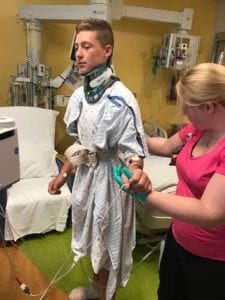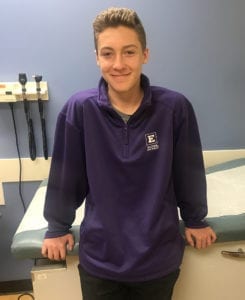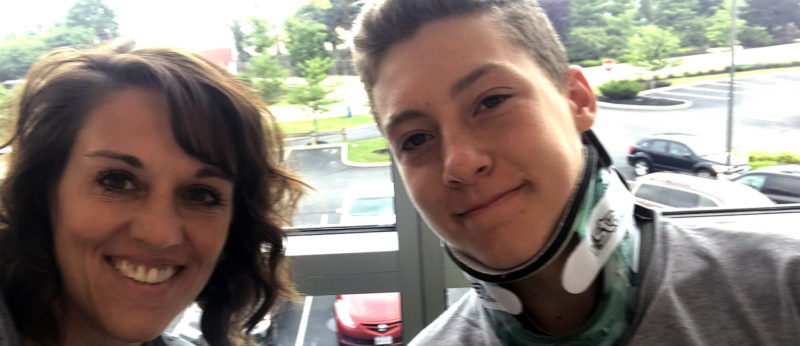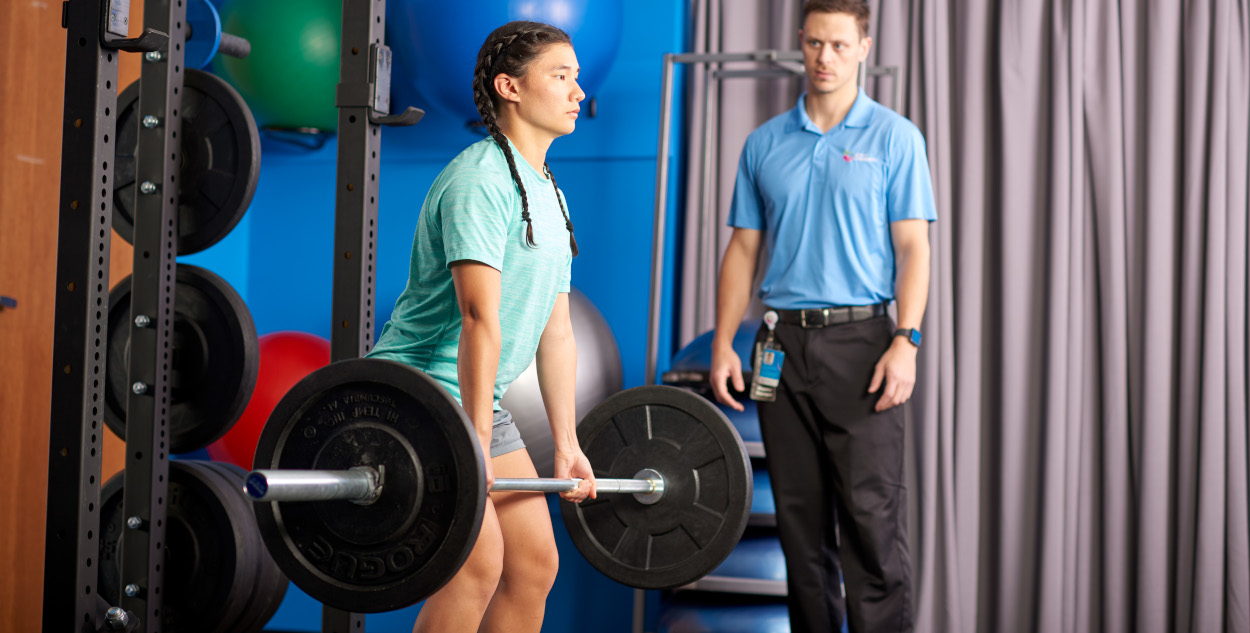Thankful doesn’t begin to describe how I feel as I reflect upon the last few months. I am thankful that my son, Anthony, is exactly where he is right now. Thankful that his injury wasn’t worse that it was. And thankful that he has recovered as quickly as he did.
Becoming a Family With A Child Who Survived a Spinal Cord Injury
You see, this summer didn’t go exactly how we had planned. On July 30, 2018, we became a family with a child who survived a spinal cord injury. I never imagined that I would be writing those words.
It all started when I received a call from Anthony. He explained that he had pulled a muscle in his back when he dove off the diving board into a 12-foot pool. He didn’t hit his head. But he felt something pull or twitch in his back as he hit the water. So he got out of the pool and went to the lifeguard area to explain that his neck and back hurt. After sitting down for about 45 minutes, he noticed that his fingertips were starting to go numb. He felt so bad that he decided to go home. He grabbed his keys but his fingers were too numb to press the unlock button. I am very proud of him for asking his friend to drive him home.
When he called, I told him to take some Advil, go lie down and put some ice on it. I called back about an hour later to check on him, and he said that it had gotten worse. Plus, he was seeing double. I started to panic. My husband picked him up and took him to the ER and I met them there.
A Visit to the Emergency Room
When I saw my husband carrying him from the car to the ER entrance, my heart sank. Not only had I let him sit at home in pain, but the situation looked way more serious than I ever expected. Anthony was almost dead weight in my husband’s arms and flushed all over.
He had barely finished telling the triage nurse what happened when he was rushed back to the trauma room. He was immediately put into a cervical spine collar. They kept asking him if he had hit his head on something and I can remember him saying, “I thought the dive was really good until I felt something in my back.” One simple dive will forever change our lives. *
The trauma team called in neurology and ordered an MRI and CT scan to rule out any spinal fractures and to check for bleeding. The good news was that there was no fracture, but they wanted to admit him to the ICU for observation. They were concerned about his pain level, weakness in his arms and legs and his inability to move them. So he was admitted to the ICU with so many fears and so much uncertainty.
The Next Couple of Days
The next couple of days were a whirlwind as the medical team tried to determine what was wrong. He had a contrast MRI and an MRA (angiogram of his brain). Anthony didn’t fit a textbook spinal injury. Typically, with numbness and weakness, someone will endure blunt force to the head or neck. They wondered if he had hyper-extended his neck when he hit the water. Alternatively, maybe there was something else going on in his body and this happened because of another problem.
The results showed that he had swelling in his spinal cord at the cervical and thoracic spine. Our team explained that this is typical for those who hyper-extend their spine. They wanted him to stay in a c-collar for the foreseeable future and keep him on medicine to maintain an elevated arterial blood pressure for seven days. This was to help with blood flow to his spine to help with healing. 
He also started physical therapy. During his first session, he was able to stand for the first time in two days. He even took a couple of steps! However, he continued to have weakness and numbness in all of his limbs, but especially in his arms and hands.
We Get To Go Home
By the seventh day, Anthony was discharged from the ICU. It was so wonderful and so anxiety producing all at the same time. It felt like the first night when I brought him home from the hospital right after he was born. I was fearful that I wouldn’t hear him if he needed me or he would get up on his own and get dizzy. Anthony, on the other hand, was 100% thrilled. To be able to eat, shower and sleep by himself felt amazing. He still had to wear the cervical collar 24 hours a day, but we worked on gaining his independence back. The stairs were the most difficult and required someone to help.
We continued physical and occupational therapy both at Cincinnati Children’s and at home. Endurance, balance and functionality were all things he had to work on. He still had numbness and a lack of pain sensation in his right leg, as well as difficulty using his hands. I tried my best to not be fearful, knowing that the first six months are the most important for recovery. My friends reminded me that it had only been a few weeks.
Anthony Now

While we’ve had some ups and downs along the way, I am happy to report that four months later, Anthony is doing amazing. He was finally able to take the cervical collar off two months after the accident. He has been released from neuro rehab and will continue doing weekly physical and occupational therapy. The focus will be to regain as much strength as possible so that he can go back to his normal activities. This even includes driving!
Giving Thanks for Where He Is
I am so thankful for where Anthony is right now. Looking back, his injury could have been so much worse than it was. But four months later, he has regained all of his functionality, lost the numbness, and is working on regaining all of his strength. I am thankful that Anthony is a fighter. He has shown nothing but courage, strength, and kindness as he has nearly fully recovered from a fluke accident that changed the course of our lives. He is stronger because of it. And he’s a survivor.
* Editor’s note: Anthony’s injury was very unique for a healthy teenager diving into a pool of appropriate depth. Most pediatric neurologic injuries related to diving involve injuries from head-first dives into dangerously shallow depths of less than eight feet.





